In an era marked by rapid technological advancements and shifting market dynamics, B2B lead generation stands at a crossroads.
As businesses grapple with increasingly complex buyer journeys, the traditional methodologies of generating leads are being transformed by new technologies and strategies that promise greater efficiency and alignment with customer needs.
From artificial intelligence enhancing lead scoring to the rise of personalized marketing campaigns driven by intent data, the landscape of B2B lead generation is evolving at an unprecedented pace.
This article delves into the current and emerging trends shaping the future of B2B lead generation, offering businesses crucial insights on how to navigate this ever-changing terrain.
As we explore these trends, we also raise pivotal questions: Who really needs to adapt these advanced strategies? And what are the most effective ways for B2B marketers to harness these new tools for growth and success?
Introduction to B2B Lead Generation: What’s Changing?

With increase use of technology in our lives and changes to the way in which products and services are delivered, there are some changes that are being felt in the b2b sales landscape.
- Increasing Emphasis on Account-Based Marketing (ABM): ABM is becoming more vital as it allows for highly targeted, personalized engagement with key accounts, fostering deeper connections and higher conversion rates.
- Advanced Utilization of Predictive Analytics: By leveraging historical data and machine learning, predictive analytics are increasingly used to forecast potential customer behaviors and preferences, thus refining lead targeting and enhancing the effectiveness of marketing campaigns.
- Rise of AI-Driven Sales Enablement Tools: These platforms are evolving to provide more comprehensive support for sales teams through real-time data analytics and automation, significantly improving sales process efficiency and effectiveness.
- Greater Focus on Personalization at Scale: Businesses are increasingly expected to deliver personalized customer experiences. Utilizing AI and data analytics helps tailor interactions and content to individual needs and preferences across various touchpoints.
- Integration of Advanced Digital Security Measures: As reliance on digital tools grows, so does the focus on cybersecurity. Protecting sensitive customer data through robust security practices is becoming a crucial part of maintaining trust and compliance in B2B transactions.
Despite these changes, there are foundational elements in B2B lead generation that remain unchanged which you can see as a subtle trend in the above mentioned changes.
(i) Personal Relationships: Building and maintaining strong personal connections continues to be a cornerstone of effective B2B lead generation.
(ii) Meaningful References: Leveraging customer references and case studies from satisfied customers remains a powerful tool for establishing credibility and trust with potential leads
(iii) Reputation and Word of Mouth: A strong reputation and the power of word-of-mouth referrals continue to be invaluable assets that significantly impact lead generation success.
These insights blend both the evolving and the enduring aspects of B2B lead generation, highlighting how companies can adapt to new trends while grounding their strategies in proven traditional practices.
The Rising Importance of Artificial Intelligence in Lead Scoring
Lead scoring is a fundamental component in the B2B lead generation process, serving as a vital mechanism for prioritizing leads according to their potential to convert into customers. You can read this detailed article on lead scoring post which you will be in a position to implement your own process.
Traditionally, lead scoring involved setting scores based on predefined criteria such as job title, company size, or interaction with specific content. However, the role of Artificial Intelligence (AI) in this arena has grown significantly, transforming lead scoring from a somewhat subjective process into a dynamic and predictive strategy.
AI enhances lead scoring by utilizing machine learning algorithms to analyze large sets of data on lead behavior and historical sales information. This allows companies to identify patterns and signals that are most indicative of a prospect’s likelihood to buy.
AI-driven lead scoring models can adapt and improve over time, continuously refining their accuracy in predicting lead quality. This capability enables sales and marketing teams to focus their efforts more efficiently, ensuring they engage with leads that have the highest conversion potential.
Moreover, AI can process and interpret data from a variety of sources, including social media activity, website interactions, and email engagement, providing a more holistic view of a lead’s engagement level.
This comprehensive approach not only improves the accuracy of lead scoring but also allows for the automation of the scoring process, which can scale as the amount of lead data grows.
Account-Based Marketing for b2b leads : More Than Just a Buzzword?
Account-Based Marketing (ABM) for B2B leads has evolved from being just a trendy concept to becoming a core strategy for companies looking to drive sustainable growth through highly targeted and personalized marketing efforts. Below is a detailed explanation of what ABM entails, how companies implement it, its benefits, and the challenges it presents, all represented in a table for clear and easy consumption.
| Aspect | Details |
|---|---|
| Definition | ABM is a strategic approach where marketing and sales teams collaborate to create personalized buying experiences for a carefully selected set of target accounts. |
| Implementation | Companies implement ABM by identifying key accounts, gathering insights on these accounts, and designing personalized campaigns that resonate with the specific needs and challenges of each account. |
| Benefits | 1. Enhanced Customer Experience: Tailored interactions lead to more relevant and engaging experiences for prospects. <br> 2. Increased ROI: Focused resources on high-value accounts can lead to higher conversion rates and a better return on investment. <br> 3. Better Alignment of Sales and Marketing: Unified approach enhances communication and strategic alignment between departments. |
| Challenges | 1. Resource Intensive: Requires significant investment in terms of time and personnel to research and personalize marketing efforts. <br> 2. Data Quality: Success heavily relies on the quality of data about potential clients; inaccurate data can lead to wasted efforts. <br> 3. Scaling Issues: While effective for high-value accounts, it can be challenging to scale across larger segments of potential leads. |
ABM is more than a mere buzzword; it’s a transformation in how B2B companies approach the market, promising to turn potential high-value relationships into profitable engagements by treating individual accounts as markets in their own right.
However, the effectiveness of ABM depends significantly on the commitment of an organization to deep research, personalized content creation, and ongoing engagement strategies tailored to each account’s context and needs.
Harnessing Buyer Intent Data for More Personalized Outreach

Harnessing buyer intent data in a B2B context involves understanding and targeting the specific individuals within a business who are actively researching products or services like yours.
This approach differs significantly from B2C marketing as it focuses on identifying and engaging with individuals based on their professional roles and the current needs of their companies rather than personal consumer behaviors.
Implementation Nuances in B2B lead generation Context:
- Identifying Key Decision-Makers: Unlike B2C, where individual consumer preferences can guide marketing efforts, B2B marketing must target specific roles within a company that influence purchasing decisions. This requires understanding the hierarchy and decision-making processes within target organizations.
- Contextual Relevance: Content and outreach must be tailored not just to the individual but to their business context. This involves demonstrating how your solution addresses their specific business challenges and aligns with their strategic goals.
- Longer Sales Cycles: B2B sales cycles are typically longer, involving multiple touchpoints and stakeholders. Using intent data can help in nurturing leads through these prolonged cycles by providing timely and relevant interactions based on the lead’s engagement and research activities.
Best Practices for Utilizing Buyer Intent Data:
- Data-Driven Personalization: Use the insights from intent data to personalize communications at scale. Tailoring messages and offers based on the specific interests and behaviors of each lead increases the likelihood of engagement.
- Timely Follow-Ups: Respond to signals of intent promptly. For example, if a key stakeholder is exploring articles on a specific solution, timely, targeted outreach regarding that solution can make your offering stand out.
- Integrated Sales and Marketing Efforts: Ensure that the insights derived from intent data are shared across both sales and marketing teams to coordinate efforts and messaging, enhancing the overall effectiveness of the outreach.
Reliable Sources of Buyer Intent Data:
- First-Party Data: Data collected from your own digital properties, such as website visits, downloads, and webinar attendance. This data is highly relevant as it shows direct interest in your offerings.
- Intent Data Providers: Companies like Bombora, G2, and Demandbase specialize in tracking and analyzing buyer behaviors across the web. They aggregate data from various sources to provide insights into which companies are researching topics related to your products.
- Social Media Listening Tools: Platforms like LinkedIn Navigator and Hootsuite can be used to monitor discussions and content engagement related to specific industry topics, offering insights into which organizations and roles are showing interest in areas relevant to your business.
- Content Syndication Networks: These networks distribute your content across various platforms and collect data on engagement, helping identify potential leads who are consuming content related to your market niche.
By integrating these reliable sources of data into your marketing strategies, you can more effectively target and engage with B2B prospects, enhancing the precision and effectiveness of your sales and marketing efforts.
The Shift Toward Customer-Centric Marketing Strategies in B2B
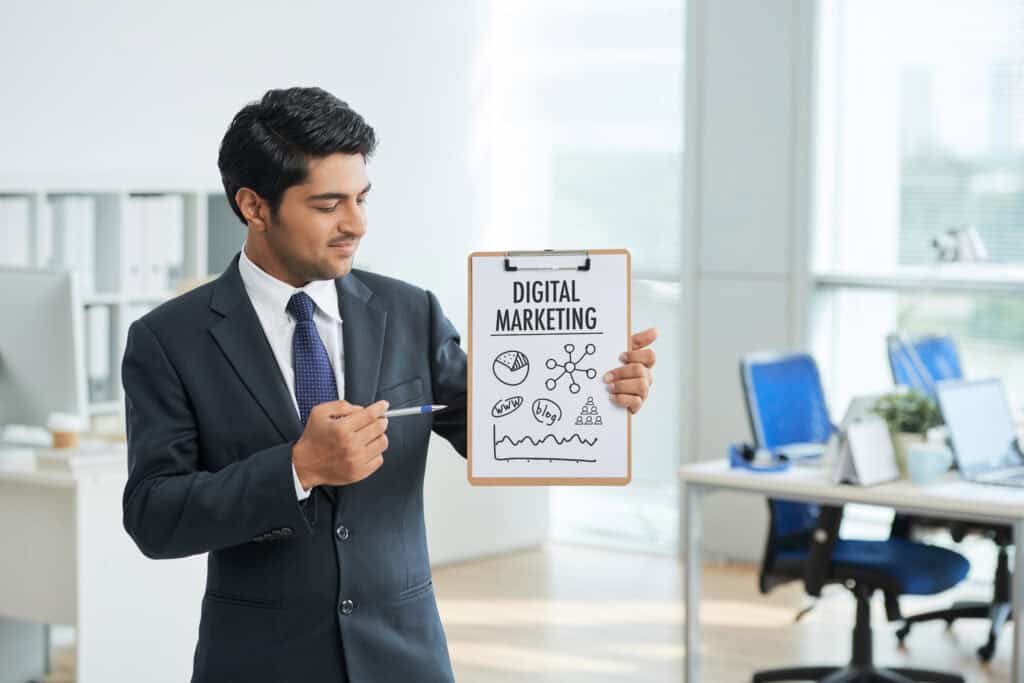
The shift toward customer-centric marketing strategies in B2B refers to aligning marketing efforts to focus primarily on the customer’s needs and experiences rather than solely on the product or service being sold.
This approach emphasizes understanding and addressing the specific requirements, challenges, and objectives of each customer, thereby fostering stronger relationships and driving growth through increased customer loyalty and satisfaction.
Real-World Examples of Customer-Centric B2B Companies:
- Amazon Business: Known for its consumer-centric approach, Amazon has successfully translated this into the B2B sector with Amazon Business. They offer tailored purchase solutions, integrating seamlessly into various procurement systems, thereby making the buying process more convenient for business customers.
- Adobe: Adobe’s shift from selling perpetual software licenses to a subscription-based model under Adobe Creative Cloud is an excellent example of customer-centricity. This change was driven by the needs of their customers for more flexible, scalable, and accessible design tools.
- Slack: This collaboration tool excels in customer-centricity by providing a platform that integrates with a multitude of work tools, thus positioning itself as an indispensable asset in various business workflows and enhancing overall user experience.
Top 5 Things Businesses Need to Keep in Mind for Customer-Centric Marketing:
- Deep Understanding of Customer Needs: Businesses must invest in research to deeply understand their customers’ industries, challenges, and workflows. This knowledge allows companies to tailor their offerings to better meet the specific needs of each customer.
- Personalization at Scale: Leveraging technology to deliver personalized experiences at scale is crucial. This includes customized communications, tailored solutions, and personal engagement strategies that resonate with each customer’s unique needs.
- Feedback Loops: Establishing robust mechanisms to gather and act on customer feedback is essential. This continuous loop helps businesses remain aligned with customer expectations and adapt their offerings accordingly.
- Employee Empowerment: Employees should be empowered with the right tools and information to make customer-oriented decisions. Training and supporting teams to prioritize customer needs can lead to more effective and responsive customer service.
- Long-term Relationship Focus: Instead of focusing solely on immediate sales, businesses should cultivate long-term relationships with their customers. This involves consistent follow-up, ongoing support, and regular check-ins to ensure that the product or service continues to meet the evolving needs of the customer.
Adopting a customer-centric approach in B2B marketing not only improves customer satisfaction and loyalty but also enhances the overall brand reputation, leading to sustained business growth.
Video Content: The New Frontier in Lead Generation
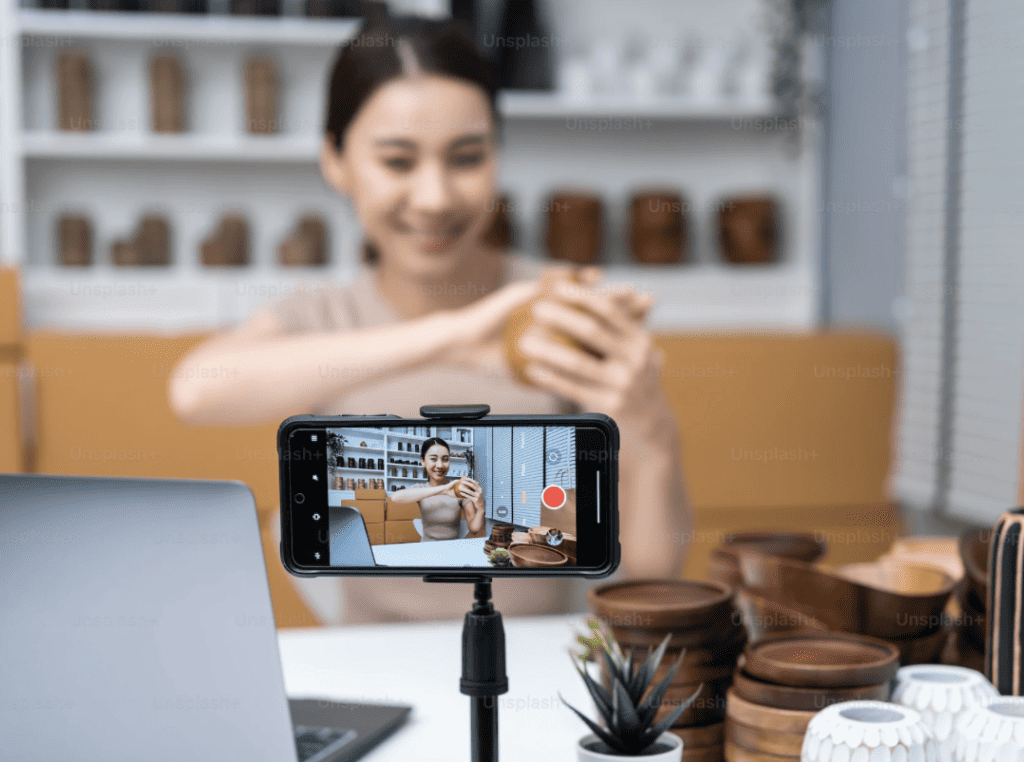
Video content is increasingly recognized as a powerful tool in B2B lead generation. It offers a dynamic way to present information and engage with potential clients, setting the stage for deeper understanding and trust between businesses.
How Videos Help in B2B Lead Generation:
- Enhanced Engagement: Videos are highly engaging and can capture the attention of potential clients more effectively than text-based content. They offer a quicker and more impactful way to communicate the value proposition of a product or service.
- Complex Information Simplified: B2B products and services often involve complex concepts that can be difficult to convey through text alone. Videos can simplify these concepts through visual aids and demonstrations, making it easier for potential clients to understand and see the value.
- Increased Retention Rates: Information presented in video format is more likely to be remembered than information read in text. This increased retention can lead to stronger brand recall and a higher likelihood of lead conversion.
Building Credibility and Thought Leadership:
The B2B space is crowded with promotional content that often skims the surface without providing real value. To stand out, companies should focus on creating video content that not only promotes their products but also establishes their credibility and positions them as thought leaders. This involves:
- Educational Content: Producing video content that educates the audience about industry trends, challenges, and solutions. This type of content demonstrates a deep understanding of the industry and builds trust with potential clients.
- Customer Testimonials and Case Studies: Showcasing real-life examples of how a product or service has solved complex business problems can significantly enhance credibility. Videos featuring customer testimonials or detailed case studies provide tangible proof of a company’s capabilities and results.
- Expert Interviews: Videos featuring interviews with industry experts or thought leaders can further enhance a company’s credibility. These videos can delve into industry insights, offer valuable advice, and discuss emerging trends, all of which can attract a more engaged and informed audience.
Implementing High-Quality Video Content:
To truly benefit from video in B2B lead generation, companies must ensure the content is high-quality and relevant. This includes proper scripting, professional production values, clear audio, and visuals that reinforce the message.
Additionally, distributing video content through the right channels—such as LinkedIn, industry blogs, or direct email campaigns—is crucial to ensuring it reaches the intended audience.
In essence, while promotional videos are common, B2B companies that invest in creating informative, credible, and professionally produced video content can significantly enhance their lead generation efforts and establish themselves as trusted leaders in their field.
The Impact of Automation and AI on Lead Generation Processes

AI-driven lead generation and AI funnels are transforming how businesses identify and engage with potential customers, enhancing the efficiency and effectiveness of marketing strategies.
What is AI Lead Generation?
AI lead generation involves using artificial intelligence technologies to automate and enhance the process of identifying and capturing potential leads.
This can include the use of machine learning algorithms to analyze large sets of data to predict which customers are most likely to convert, and deploying AI to streamline lead nurturing processes through personalized messaging and interactions.
What are AI Funnels?
AI funnels refer to the automated systems that guide potential leads through a sales process, from initial contact through to conversion, using AI technologies.
These funnels are designed to respond dynamically to the actions and behaviors of prospects, providing tailored experiences that are optimized to increase the likelihood of conversion.
AI funnels can adapt in real-time, modifying the path and interactions based on user responses or predictive analytics.
Benefits When Used Wisely:
- Increased Efficiency: AI can handle repetitive tasks and manage large volumes of data quickly, freeing up human resources for more strategic activities.
- Enhanced Personalization: By analyzing data on past interactions and behaviors, AI can help tailor communications and offers to the specific needs and interests of each lead, increasing the chances of conversion.
- Improved Scaling: AI systems can manage and nurture leads at scale without the need for proportional increases in human oversight or intervention, allowing businesses to grow their lead generation efforts more sustainably.
Drawbacks When Used Improperly:
- Lack of Human Touch: Over-reliance on automation can result in interactions that lack the personal touch, which can be crucial in building trust and relationships, especially in complex B2B contexts.
- Misalignment with Target Audience: Without a thorough understanding of the target audience and proper configuration, AI systems might deliver content that is not aligned with the needs or interests of the prospects, leading to lower engagement rates.
- Data Dependency: AI systems are heavily dependent on the quality and breadth of the data they are fed. Poor data quality or insufficient data can lead to inaccurate predictions and ineffective lead nurturing, potentially damaging the brand’s reputation and wasting resources.
For businesses considering the integration of AI into their lead generation processes, it’s essential to balance the use of technology with human insight.
The key is to ensure that AI solutions are properly trained, continuously monitored, and regularly updated to align with evolving market conditions and business objectives.
This approach ensures that AI not only automates tasks but also enhances the strategic capabilities of the marketing and sales teams.
Integration of Tech Tools: CRM and Beyond
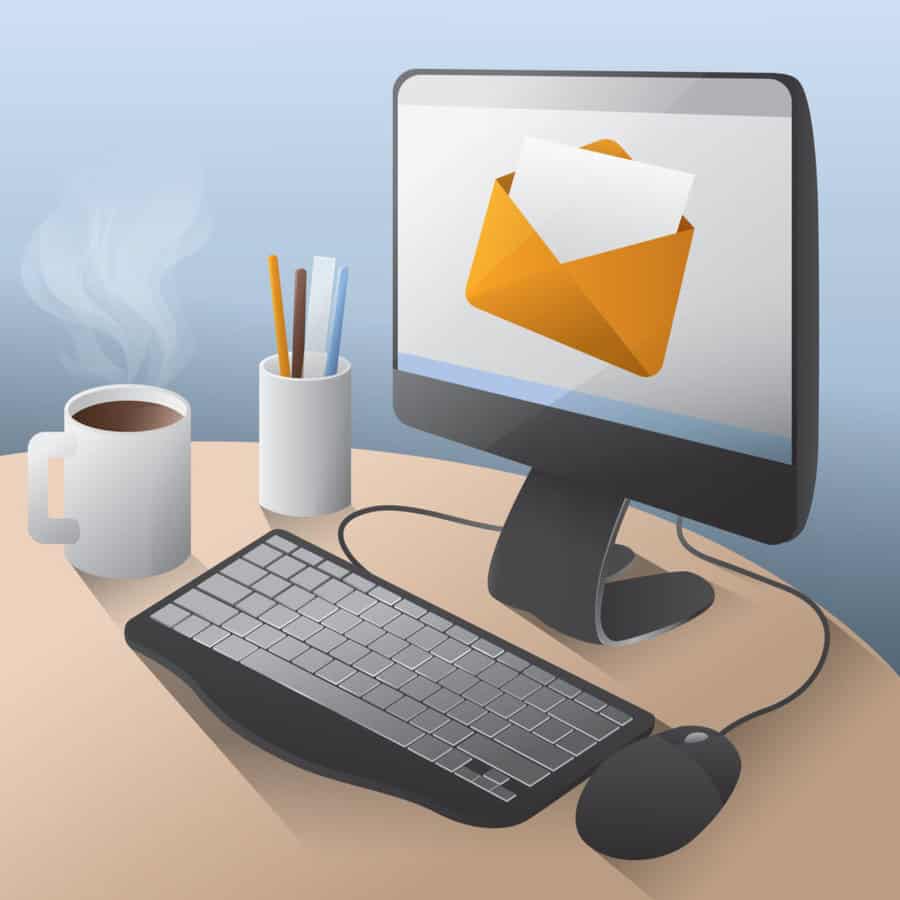
In a B2B lead generation campaign, the integration of tech tools, particularly CRM systems, plays a pivotal role in offering a comprehensive view of the customer. Beyond CRM, the use of additional integrated tools can enhance understanding and interaction throughout the customer journey.
Here’s a breakdown of essential tools and the importance of integrating customer service:
Essential Tech Tools for a 360-Degree Customer View:
- CRM Systems (Customer Relationship Management): The backbone of any lead generation campaign, CRM systems store all customer interactions, sales history, and other crucial data. Tools like Salesforce, HubSpot, or Microsoft Dynamics provide a centralized platform to track leads, monitor sales processes, and analyze customer interactions.
- Marketing Automation Platforms: These tools automate and measure marketing tasks and workflows to increase operational efficiency and grow revenue faster. Examples include Marketo, Eloqua, and Pardot. They work alongside CRMs to nurture leads through automated emails, social media posts, and content marketing tailored to various stages of the customer journey.
- Analytics and Data Visualization Tools: Tools like Google Analytics, Tableau, or Power BI help visualize complex data sets and provide insights into customer behavior, campaign performance, and website traffic. These insights are crucial for making data-driven decisions that align with business goals.
- Customer Data Platforms (CDPs): CDPs collect, organize, and analyze customer data from multiple sources to create a comprehensive customer profile. This integration provides deeper insights into customer preferences and behavior, helping tailor marketing efforts more effectively.
- Communication Tools: Platforms like Slack or Microsoft Teams ensure that teams across departments stay informed and coordinated regarding customer interactions and lead status.
Integrating Customer Service:
Integrating customer service into these tech tools is crucial for several reasons:
- Consistent Customer Experience: Seamless integration ensures that all touchpoints with the customer are informed by previous interactions, regardless of the communication channel. This consistency helps build trust and strengthens customer relationships.
- Real-Time Response and Support: Integrated customer service tools like live chat or AI chatbots can provide immediate assistance to inquiries or issues, enhancing the customer experience and increasing the likelihood of conversion.
- Feedback Loop for Improvement: Customer service interactions offer valuable feedback which can be leveraged to improve products and services. Integrated tools can analyze this feedback to identify trends and areas for enhancement in real-time.
- Enhanced Customer Retention: Effective customer service is a key driver of customer satisfaction and retention. Integrated tools help ensure that customers receive timely and effective solutions, fostering long-term loyalty.
Overall, the integration of these tech tools creates a synergistic effect that enhances the efficiency and effectiveness of B2B lead generation campaigns.
By maintaining a holistic view of the customer and ensuring all departments are aligned in their approach, businesses can not only attract but also retain valuable customers in a competitive market landscape.
What is the Future of B2B Sales? Visualizing Changes
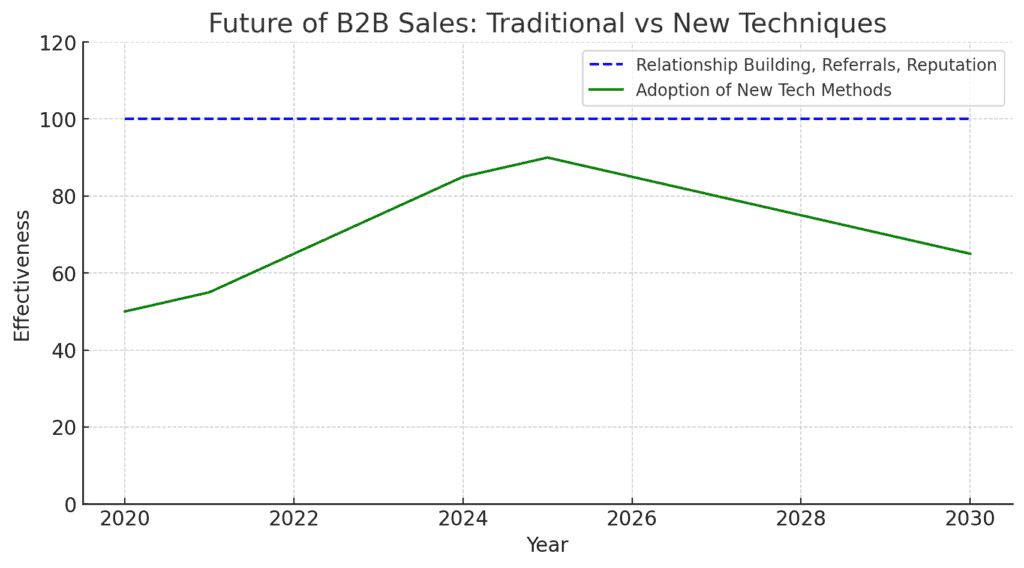
Despite the introduction and fluctuating popularity of new technological methods, the foundational strategies such as relationship building, good referrals, and building a solid reputation remain consistently effective (shown by the blue dashed line).
These traditional methods maintain their value due to their fundamental role in fostering trust and personal connections, which are critical in B2B contexts.
On the other hand, the green line illustrates the rise and potential fall in the effectiveness of new tech methods in B2B sales. While these innovative approaches can see peaks due to initial enthusiasm and effectiveness, they may experience declines as market saturation increases or as newer technologies emerge.
This trend underscores the enduring importance of foundational sales strategies amidst the evolving landscape of B2B sales technologies
What are the Statistics for B2B Lead Generation?
Here is an overview of various B2B lead generation sources and their respective sales conversion rates, presented in a table format. These rates can vary significantly depending on the industry and the specific strategies employed.
| Lead Generation Source | Average Conversion Rate |
|---|---|
| Email Marketing | 2.53% |
| Google Ads (Paid Search) | 2.23% to 3.6% |
| Organic Search | 0.7% to 5.9% |
| Social Media | 1% to 2.1% |
| Direct Traffic | Not completely available for b2b |
These conversion rates highlight the variability and specific effectiveness of each channel. Email marketing remains a strong performer across various B2B sectors due to its personalized nature and direct engagement with potential leads. Paid search, such as Google Ads, shows a notable range in effectiveness, influenced by factors like industry-specific keywords and ad quality.
Organic search conversions vary widely, reflecting the challenge of ranking high in search results and the competitive nature of SEO. Social media, while having a lower conversion rate, still plays a critical role in lead generation due to its vast reach and potential for engagement.
Direct traffic, although challenging to track due to privacy regulations and the lack of source information, is significant as it indicates high brand recall or direct interest from previous interactions.
It’s crucial for businesses to consider these statistics when planning their B2B lead generation strategies to optimize their marketing efforts for better conversion rates.
In addition to the above mentioned digital sources, there are some offline sources as well that work well for b2b lead campaigns.
| Lead Generation Source | Average Conversion Rate | Lead Volume |
|---|---|---|
| Networking Events | 5% – 10% | Medium |
| LinkedIn Campaigns | 2.74% | High |
| Trade Shows | 3% – 5% | High |
| Gala Events | 2% – 5% | Medium |
| Organic Online Channels | 0.7% – 7% | High |
- Networking Events: These events provide an opportunity to connect directly with potential leads and build meaningful relationships. The conversion rates are typically higher because of the personal engagement and targeted audience.
- LinkedIn Campaigns: As a platform tailored for professional networking, LinkedIn facilitates targeted outreach and content distribution, which explains its relatively high conversion rate compared to other social platforms.
- Trade Shows: These events attract individuals who are already interested in the specific industries, leading to a higher conversion rate due to the relevant and engaged audience.
- Gala Events: Similar to trade shows, gala events offer a chance to engage with prospects in a more formal setting, which can lead to meaningful interactions and potentially higher conversion rates, though the volume might be lower compared to more broad-based events.
Each of these sources has its place in a comprehensive B2B lead generation strategy. It’s crucial to not only focus on the methods with the highest conversion rates but also to consider the volume and quality of leads generated to ensure a balanced and effective lead generation portfolio
Emerging B2B Lead Generation Platforms and Tools
In the evolving landscape of B2B lead generation for 2024, several innovative platforms and tools are emerging as game-changers, helping businesses enhance their lead generation strategies effectively.
Here’s a concise overview of some of the top tools that could be invaluable for your B2B lead generation efforts:
| Tool | Primary Function | Alternatives |
|---|---|---|
| Lemlist | Email outreach automation and personalization | Woodpecker, Outreach, Yesware |
| Mailshake | Email marketing automation | Sendinblue, ActiveCampaign, MailerLite, Brevo |
| We-Connect | LinkedIn automation | Dux-Soup, LinkedHelper, Zopto |
| Hunter | Email finding and verification | Voila Norbert, Snov.io, FindThatLead |
| Leadfeeder | Website visitor identification | Albacross, Visitor Queue, Lead Forensics |
| LinkedIn Sales Navigator | Advanced LinkedIn prospecting tool | Apollo.io, ZoomInfo, DiscoverOrg |
| Intercom | Customer messaging and engagement platform | Drift, Zendesk, Freshdesk |
Each of these tools and their alternatives offer robust features that can significantly enhance your B2B lead generation efforts.
They provide a range of functionalities from email marketing automation to advanced prospecting tools, ensuring that there’s a solution that fits various business needs.
Whether you’re looking to improve your email outreach, enhance your LinkedIn prospecting, or better engage with website visitors, these tools provide effective solutions to help you generate and nurture leads more efficiently.
Who Needs B2B Lead Generation? Identifying Your Audience
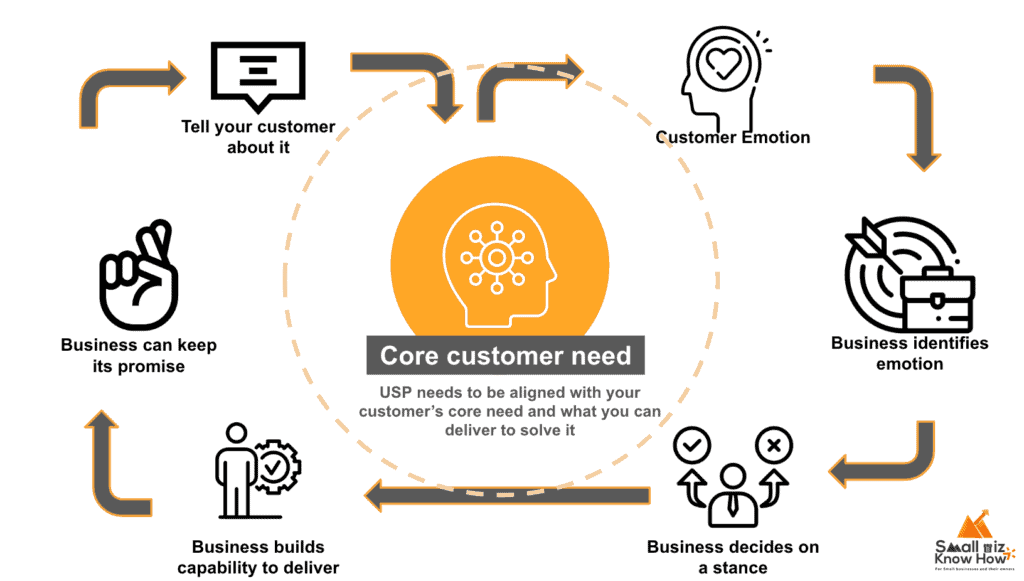
Lets look at a case study on how one should approach this. I am taking inspiration from my friend’s business where he is a distributor for advanced audio and visual equipment.
As a marketer tasked with generating leads for selling audio-visual equipment, my primary goal is to identify potential businesses and key personnel within those businesses who might need our products.
Here’s how I would approach the task, targeting office interior companies, religious institutions, academic institutions, and venues like bars and cafes:
Step 1: Defining the Ideal Customer Profile (ICP) First, I begin by defining the Ideal Customer Profile for each segment. For office interior companies, the focus is on those designing or refurbishing office spaces with modern amenities.
For religious and academic institutions, I look for those upgrading their facilities or building new ones. Bars and cafes are targeted based on their emphasis on enhancing customer experience through ambient improvements.
Step 2: Research and Data Gathering Using a combination of online tools like LinkedIn Sales Navigator, industry databases, and local business registries, I gather data about businesses in the defined categories.
This includes size, location, recent funding for renovations or expansions, and any upcoming projects that have been publicized.
Step 3: Identifying Decision Makers Once I have a list of potential businesses, I identify key decision-makers within these organizations. This might include facility managers, IT directors, or owners in the case of smaller businesses like bars and cafes.
For institutions like universities or churches, I might focus on administrative directors or the head of procurement.
Step 4: Tailoring Communication For each segment, I develop tailored messaging that highlights how our audio-visual solutions can enhance their specific environment.
For office interior companies, I emphasize seamless integration and aesthetic enhancement. For religious institutions, I focus on the ability to facilitate larger congregations through better sound and visuals.
For academic settings, the pitch revolves around interactive learning enhancements. Bars and cafes would be interested in how our solutions can create the right ambiance and attract more patrons.
Step 5: Multi-channel Outreach I deploy a multi-channel outreach strategy. This includes direct emails, setting up booths at trade shows relevant to each sector, digital advertising targeting these sectors, and leveraging social media platforms like LinkedIn for direct messaging and engagement.
Step 6: Engagement and Follow-Up After the initial contact, I engage interested leads with more detailed information, possibly setting up demonstrations or site visits.
I use a CRM tool to track interactions, feedback, and the status of each lead. Follow-up communications are tailored based on the interest and responses received, pushing towards setting up meetings or calls with sales representatives.
Step 7: Refining and Repeating Based on the responses and success rates from these efforts, I continually refine our approach, targeting, and messaging. Feedback from potential and converted leads is crucial in understanding what works and what needs adjustment.
Example Scenario: Imagine I’m reaching out to an office interior design company.
My research indicates they are currently involved in a large project for a tech startup’s new headquarters. My initial email would highlight our latest state-of-the-art audio-visual integration systems that blend perfectly with modern aesthetics, support tech-savvy environments, and offer long-term reliability.
I would attach case studies similar to their project and propose a brief call or meeting to discuss potential custom solutions for their current project.
This systematic approach ensures that our marketing efforts are focused, efficient, and continuously improving, increasing the likelihood of generating high-quality leads for our audio-visual equipment business.
What are 4 Efficient Lead Generation Strategies for B2B Marketers?

In the realm of B2B marketing, certain strategies have proven to be particularly effective for generating leads. Here, we explore four evergreen strategies: Referrals, Reputation, Word of Mouth, and Building Thought Leadership.
- Referrals
- Why It Works: Referrals naturally arise from satisfied customers who share their positive experiences with peers. This form of lead generation is highly trusted because it comes from a known and trusted source, reducing the perceived risk for the new potential client.
- How to Implement:
- Offer incentives for referrals to both the referrer and the referee.
- Make the referral process as easy as possible with simple tools or forms on your website.
- Regularly remind customers of the referral program through newsletters and during service interactions.
- Reputation
- Why It Works: A solid reputation establishes a firm as reliable and credible, which is crucial in B2B markets where the stakes are often high.
- How to Implement:
- Actively manage online reviews and promptly address any negative feedback.
- Showcase awards, certifications, and endorsements prominently on your digital platforms.
- Invest in quality assurance and customer service to maintain high standards.
- Word of Mouth
- Why It Works: Similar to referrals, word of mouth is driven by customer satisfaction and the natural inclination to share good experiences. It’s a powerful tool that spreads organically.
- How to Implement:
- Deliver exceptional customer service that clients want to talk about.
- Engage actively with clients on social media and encourage them to share their experiences.
- Host events or webinars that clients can invite their peers to.
- Building Thought Leadership
- Why It Works: By positioning oneself as an expert in the industry, a company not only gains respect but also attracts leads who are interested in top-tier knowledge and solutions.
- How to Implement:
- Publish insightful content such as whitepapers, research findings, and blog posts.
- Speak at industry conferences or host seminars and webinars.
- Participate in industry panels and contribute to professional publications.
Checklist for Implementing b2b lead generation Strategies Effectively
- Develop a Referral Program:
- Implement an easy-to-use referral system.
- Communicate regularly with existing customers about the benefits of referring new clients.
- Maintain a Strong Online Presence:
- Regularly update your website and social media with positive testimonials and case studies.
- Monitor and respond to reviews on platforms relevant to your industry.
- Engage in Community and Industry Events:
- Sponsor or participate in events that your target customers attend.
- Create networking opportunities for your clients to share their experiences with others.
- Create and Distribute High-Quality Content:
- Establish a content calendar that addresses current industry issues and showcases your expertise.
- Use multiple channels to distribute content, including email newsletters, social media, and industry forums.
- Measure and Optimize:
- Track the effectiveness of each strategy through metrics such as lead conversion rates, customer satisfaction scores, and engagement levels.
- Continuously refine strategies based on performance data to improve ROI.
Implementing these strategies effectively requires a focused approach and ongoing adjustments based on feedback and performance data. By systematically applying these strategies, businesses can enhance their lead generation efforts and build a robust pipeline of prospective clients.
Predicting the Long-Term Trends in B2B Lead Generation
There is a very interesting analysis that I have done after speaking to a few people who practice B2B marketing across the industry.
I have tried to translate their insights into a model that predicts how B2B leads can trend over the next few years.
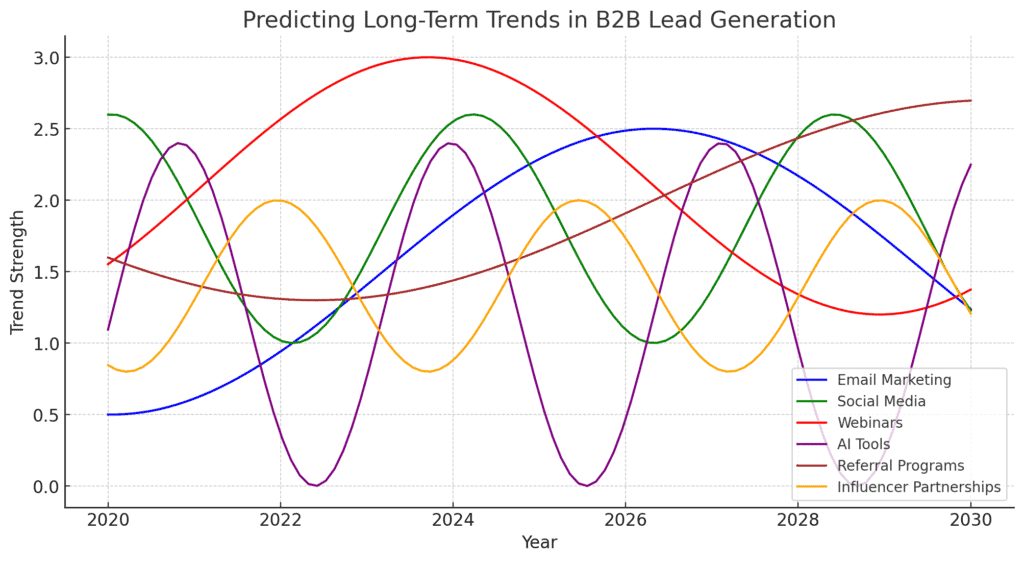
- Email Marketing (Blue Line): Exhibits a longer wavelength, emphasizing its stability and consistent effectiveness in lead generation over time.
- Social Media (Green Line): Shows a shorter wavelength, indicating fluctuations and less predictability due to rapid changes in social media trends and platform dynamics.
- Webinars (Red Line): Features a longer wavelength, suggesting that webinars remain a strong and stable method for generating leads, with their value increasing as businesses seek direct engagement with their audience.
- AI Tools (Purple Line): Demonstrates a shorter wavelength with high peaks, reflecting the rapid innovation and variable adoption rates in AI technologies, which can lead to fluctuations in effectiveness.
- Referral Programs (Brown Line): Displays a longer wavelength, underscoring the steady and reliable nature of referrals as an evergreen source of high-quality leads.
- Influencer Partnerships (Orange Line): Presents a shorter wavelength, highlighting the less predictable outcomes that depend heavily on market trends and the evolving influence of thought leaders.
This visualization helps in understanding how different lead generation sources may perform over time, allowing marketers to strategize and allocate resources more effectively based on the expected stability and impact of each method.
